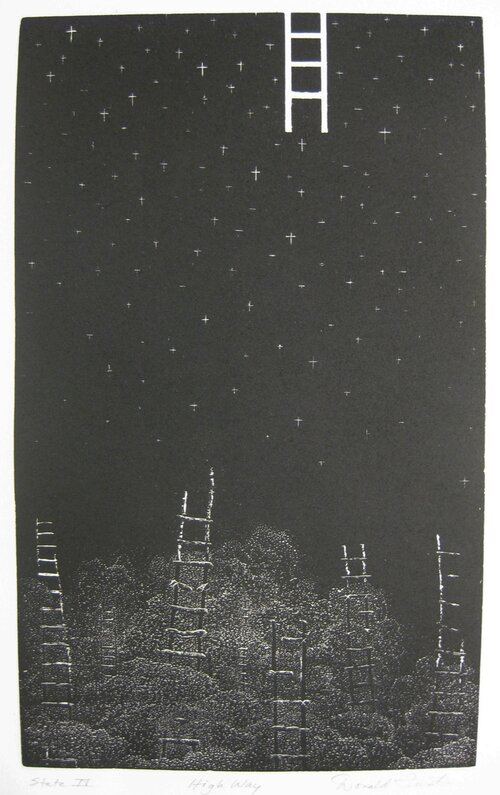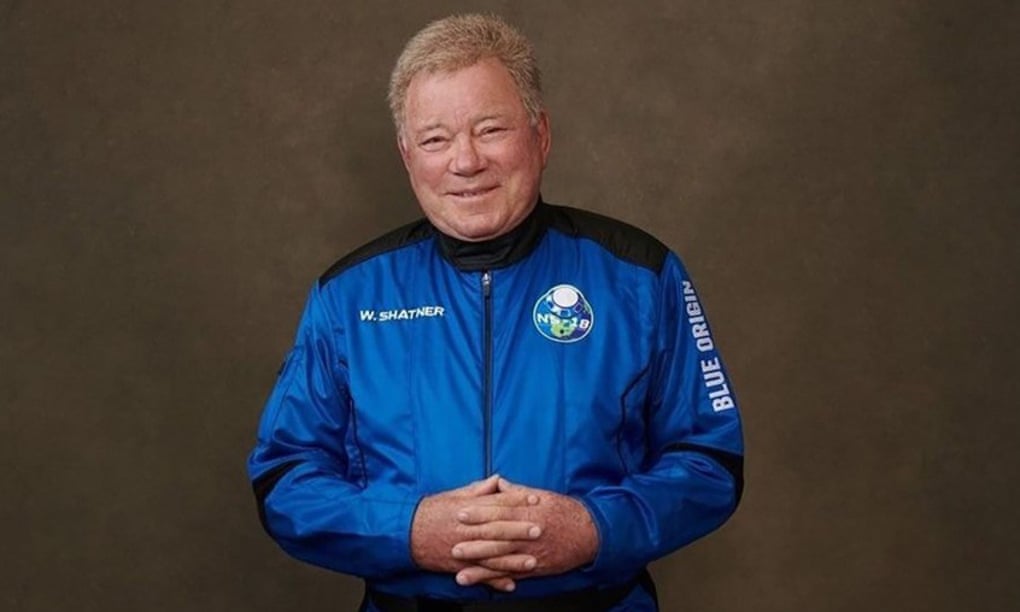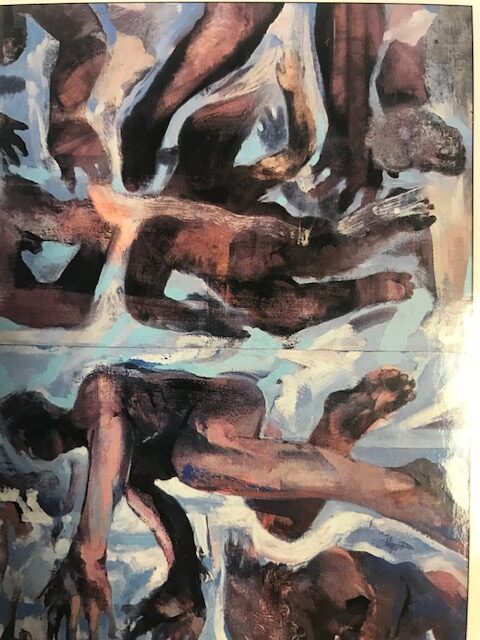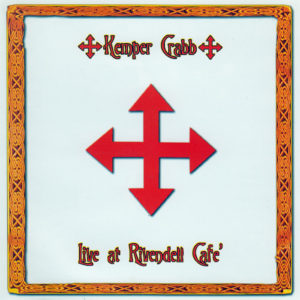My Way or the High Way

There are many ladders, rising from a woods that likely provided the branches for their construction. Each is rickety, rough-hewn, and does not inspire confidence that it would sustain the weight of the human being who was its craftsman. While the ladders stretch toward the stars, even the tallest barely reaches above the trees. That is the picture of futility we see in the bottom third of Donald Furst’s woodcut, “High Way.”
There is another ladder at the top of the image. It is pure white and perfectly formed – its right angles contrasting with the skewed rungs of the ladders below. Where they are reaching up, this ladder is descending, like Jacob’s ladder that linked heaven and earth. Indeed, its purity and perfection suggests it is of divine construction.
Above the trees is a field of stars. They seem to vary in intensity, but they share a common shape. The stars are all cruciform; the sky is filled with little crosses.
All aspects of the image combine to provide an artful presentation of spiritual truth. The Apostle Paul wrote to the Christians in Ephesus:
“For by grace you have been saved through faith, and that not of yourselves; it is the gift of God, not of works, lest anyone should boast.” (Eph. 2:8-9)
The rickety ladders in Furst’s woodcut are of human workmanship. They strive to reach a goal they can never attain. Salvation comes not through human works from below but through divine grace from above. God must provide it to us, as He provided Jacob’s ladder on which the angels ascended and descended.
But what is this ladder that will bridge the gap from earth below to heaven above? The stars provide the answer, as their cruciform shapes point us to Christ. Jesus drew on the image of Jacob’s ladder when He said to Nathanael:
“Most assuredly, I say to you, hereafter you shall see heaven open, and the angels of God ascending and descending upon the Son of Man.” (John 1:51)
Jesus Himself is the ladder upon which heaven comes to earth. On the cross, He defeated sin, death, and the devil, so that we might enter into heavenly life that begins now and will be consummated when heaven and earth are united in a new creation at His return.
The choice facing each human being is between trusting in his or her own works to reach heaven or trusting in the work of Jesus whom God has provided as the ladder of salvation. Each of us must answer the question posed by Furst’s image: My way or the High Way?
High Way, by Donald Furst. Woodcut. 13 x 8 inches. Used by permission of the artist. (www.donaldfurst.com)
2023 Reformation Conference

Pastor Michael Philliber is pastor of Heritage Presbyterian Church (PCA) in Oklahoma City, OK. After spending 20 years in the USAF.
Continue readingWilliam Shatner and King David: Contrasting Worldviews

William Shatner is most known for his acting role as Captain James T. Kirk of the Starship Enterprise on the long-running television series, Star Trek, and the movies that followed. He also holds the title as the oldest human being to fly into space. He did so at the age of 90 aboard Jeff Bezos’s Blue Origin sub-orbital capsule. In a recent interview, Shatner commented on the impact that experience had upon him:
What I experienced was not so much the flight into space, but my observation. Everybody knows we live on a small rock and that up to 12,500 feet oxygen is there. And after that, as you go higher, you get into a dead zone…. We live on a small rock. I saw the beginning of the curvature of the Earth. If I followed through, I could make a circle of this rock we live on. We are so negligible. We are so nothing. We are this small rock and this negligible solar system which is beside a mediocre star in a galaxy that is barely larger. We’re nothing. We are nothing, and that’s what I saw.
In a way, William Shatner had an experience similar to that of King David as recorded in Psalm 8. But while Shatner was looking from space upon Earth, David was looking from Earth into space. In his poem directed to God he wrote:
When I consider Your heavens, the work of Your fingers,
The moon and the stars, which You have ordained,
What is man that You are mindful of him,
And the son of man that You visit him?
There is nothing new about observing the vastness of the universe and reflecting upon the apparent insignificance of human beings upon Earth. The implication of David’s question to God is that he was tempted to draw the same conclusion as Shatner: “We are so negligible. We are so nothing.”
However, neither the modern actor nor the ancient king was entirely satisfied with that deduction. Here is the full conclusion of what William Shatner said:
We’re nothing. We are nothing, and that’s what I saw. And what else I saw was the tragedy of the extinction of life.
These two observations are difficult to reconcile. If life on earth is really nothing, then what is so tragic about the extinction of life on earth? Shatner went on to note that he has long been interested in ecology, but one has to wonder why that would be the case. On the presupposition that our planet and its living inhabitants are nothing, the extinction of life on the planet should be absolutely meaningless. If nothing becomes nothing, what is lost? And yet he sees such an event as tragic.
I suggest that is because, in his heart of hearts, William Shatner knows we are really not nothing. He knows what King David proceeded to declare to the Lord after posing his apparently despairing question:
You have made [man] a little lower than the angels,
And You have crowned him with glory and honor.
Despite the smallness of man against the backdrop of the vast universe, David recognized that mankind has an exalted status in the cosmos. He was created a “little lower than Elohim,” which can be translated either as God or angels. And he has been “crowned with glory and honor” by God Himself. Such is God’s view of the only creatures He made in His own image (Genesis 1.26).
David further reflected upon how man’s exalted status is demonstrated in the authority and responsibilities entrusted to him by God:
You have made him to have dominion over the works of Your hands;
You have put all things under his feet,
All sheep and oxen –
Even the beasts of the field,
The birds of the air,
And the fish of the sea
That pass through the paths of the seas.
It is on the basis of this dominion mandate that human beings have explored the world, extracted its resources, and applied accumulated knowledge such that the marvel of space travel has been achieved. Contrary to Shatner’s despairing conclusion, the Bible declares that we are not nothing but are, in fact, the pinnacle of creation exercising vicegerency over it in submission to God. It is because this planet is the good creation of God that extinction of life on earth is a tragedy. The Christian worldview provides a foundation for ecological concern that is not available to one who holds a materialistic/naturalistic worldview. To use the phraseology of apologist Cornelius Van Til, Shatner must borrow Christian capital to reach his conclusion. His own worldview is internally inconsistent.
King David, on the other hand, had a consistent worldview that undergirds the value of human exploration and ecological concern. And while seeing the value of man and his created environment, this worldview also looks beyond man to give credit where credit is due. Rather than ending in despair, David concludes his psalm on a note of praise:
O LORD, our Lord,
How excellent is Your name in all the earth!
Falling Angels: Painting and Poem

Falling Angels
After a painting by Bruce Herman
Lightning-fast,
the flailing figures
plummet through the heavens,
victims of a self-willed force –
the gravity of hubris.
Forsaking and forsaken,
their only choice is to embrace
with outstretched arms
the consequence of choices past.
But,
as if some law of conservation
maintained a cosmic metaphysics,
their hope lost
may be gained
by him who would strain his eyes to trace
their vapor trails of glory
upward.
Poem: © 2022, Steven C. Wright
Painting: Falling Angels, by Bruce Herman, 1993. Mixed Media. 44 x 30 inches. Used by permission of the artist. (www.bruceherman.com)
Easter Services

Psalm Sunday worship: Sunday, April 10th, 9:30 AM
Good Friday service: Friday, April 15th, 6:00 PM
Easter Sunday worship: Sunday, April 17th, 9:30 AM
Please plan to join us for these services celebrating Christ’s victory for our salvation accomplished through His death and resurrection.
Reformation Day Conference 2021

Sunday Morning:
9:30 AM: Worship Service (“The Purpose of Worship”)
11:15 AM: Sunday School (“Calvin on Worship”)
12 Noon: Potluck Fellowship Meal (Fellowship Hall)
Sunday Evening:
5 PM: Evening Worship (“Biblical Preaching”)
Dr. Joseph A. Pipa, Jr. is President Emeritus and Professor of Systematic
& Applied Theology at Greenville Presbyterian Theological Seminary. He
has served as pastor of PCA churches in Mississippi, Texas, and
California. Dr. Pipa earned his Ph.D. with a thesis on “William Perkins and
the Development of Puritan Preaching” at Westminster Theological
Seminary. He is an author of or contributor to many books, including The
Root and Branch, The Lord’s Day, Galatians: God’s Proclamation of
Liberty, and The Worship of God: Reformed Concepts of Biblical Worship.
Dr. Pipa is a frequent guest preacher and speaker at Reformed churches
and conferences.
“The Foundations” Sunday School Series

Beginning Sunday, February 7th, our youth and adults will be viewing and discussing the 12-episode Ken Ham video series, The Foundations. In Psalm 11:3, David asks, “If the foundations are destroyed, what can the righteous do?” In his convicting yet often-humorous style, Australian-born Ken Ham addresses urgent concerns in society and reveals what must be done to reach today’s culture for Christ.
The following topics will be discussed:
- The Relevance of Genesis
- Always Ready (Evangelism)
- Revealing the Unknown God
- In Six Days
- One Blood, One Race (Racism)
- Death the Enemy
Join us for The Foundations series on Sunday mornings at 11 AM.
A Prayer for President Biden

|
|
Kemper Crabb Concert

Covenant Presbyterian Church is pleased to host Kemper Crabb in concert on Sunday, October 27th at 5 PM. The concert is part of our celebration of “The Reformation and the Arts” and is free and open to all.
Kemper has written of his vision as a Christian artist:
All of creation is the Ultimate, Ongoing Work of Art. God is the Ultimate Artist, and we, created in His Image, make Art that, like everything else, reveals God. It is also true that, as Christians called to be artists, we are specifically called to utilize our gift … in such a way that men see God, His Glory, more clearly in Creation, and are thus affected by that vision.
Kemper Crabb has more than four decades of experience as a Christian musician. His first band, Redemption, released an album in 1974 that exemplifies the “Jesus Music” of that era. Redemption evolved to become ArkAngel whose Tolkien-influenced 1980 album, Warrior, is considered a classic by believers and non-believers alike. In 1982, Kemper blended Medieval and Celtic themes on The Vigil.

From the 1990’s on, Kemper has been actively performing and recording. Among a number of releases are two Christmas albums: A Medieval Christmas (1996) and Downe in Yon Forrest (2009). The latter is the soundtrack for his Christmas concert broadcast on PBS. He has performed and recorded with the bands Caedmon’s Call and Atomic Opera. His 2010 album, Reliquarium: Future Hymns from the Ancient World, was produced to honor and raise funds for his father’s missionary work.
A solo performance by Kemper Crabb is a rare treat, and we hope you’ll join us!
Church Address: 3720 N. Highland Ave., Jackson, TN 38305
